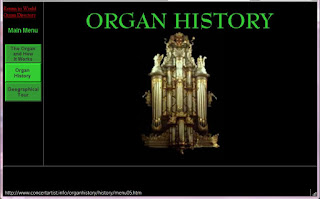As I contemplated the topic for today's lesson, I decided to share a number of available resources with you. As I mentioned before, a good, solid foundation is essential in order to progress further on the organ. Next week I'll share some creative hymn techniques, starting with hymn introductions, but first, here are some excellent resources. It is really important that you have this foundation before continuing, as I explain later in this lesson.
Music Theory
I mentioned in lesson 22 that it's a good idea to brush up on music theory, for as we continue through the lessons it would be nice to have that background. If you don't have access to a music theory book, you can look online for lessons. I haven't looked into these extensively, but here are two that I found with a quick Google search that appear to be well done:


Organ History

In lesson 21 I shared a brief history of the organ. An excellent site to learn more about organ history is:
http://www.concertartist.info/organhistory/begin.htm
There you can find a section dedicated to the organ and how it works, organ history, and a geographical tour through organ history. If you are interested in learning more than I was able to cover in lesson 21, this is an excellent resource for you.
Organ Tutor 101

Dr. Don Cook developed an interactive, multimedia approach to learning the organ. His Organ Tutor is used at BYU to teach students to play the organ. More information can be found here, including sample lessons:
http://www.ardpublications.com/
If you feel you need more help with organ technique than I'm able to give on this website, I recommend trying the sample lessons that are available, and if they help, it might be wise to purchase Organ Tutor.
Self-Study Organ Courses

BYU Independent Study offers two free organ performance courses. You can find them here (scroll down to "music"):
http://ce.byu.edu/is/site/courses/free.cfm
These are another great resource and can be taken online.
Why is a foundation important?
I've mentioned the importance of a solid foundation before, but I never explained why.
In order to use some of the creative techniques for the organ, you will need to know the following:
- What key the hymn is in, and what the tonic and dominant of that key is, in order to add a pedal point.
- How to add passing, neighbor tones, and/or suspensions to a hymn.
- How to play a hymn with the soprano, alto,and tenor in the manuals with the bass on pedal, and also how to play a hymn with proper legato technique entirely on the manuals.
- How to solo out the tenor and/or soprano while playing the remaining notes in one hand with good legato technique.
- How to play the alto line an octave higher (above the soprano line)
- How to switch the soprano and tenor lines (so the soprano is played an octave lower and the tenor is played an octave higher)
- How to play the soprano as a pedal solo while playing the alto, tenor, and bass on the manuals.
- By looking at the date the composer lived, knowing whether to play the piece in the legato style, or whether to play the piece non-legato (which will be explained in the future)
- How to transpose a hymn in your head, even to keys with six flats or five sharps.
- And more...
Homework
Begin working on hymn #3, Now Let Us Rejoice. Mark in the fingerings and pedaling. Read through the text and decide where to breathe and where not to breathe. Choose your registration. Learn the hymn as outlined in lesson 9. We will be using this hymn in our lesson next week.
Continue reviewing major scales and arpeggios and working through a piano technique book (on the piano).
Review the past lessons on this blog, keeping track of areas you need to work on.
Continue working through an organ technique book, such as Organ Tutor or the books discussed in lesson 22.
Continue playing through pieces you have previously learned, so that your progress is not lost.
Brush up on music theory using a music theory book you currently own or the websites listed above.
In Conclusion
Moving forward from this point is a lot of fun, but it also requires a commitment to proper organ technique and theory. I'm very excited to continue on this course with you!
Continue on to Lesson 24.




No comments:
Post a Comment